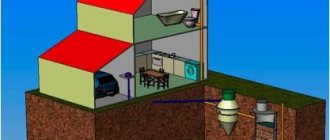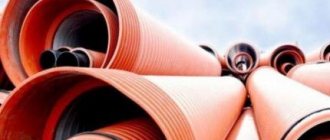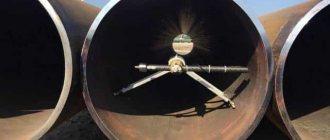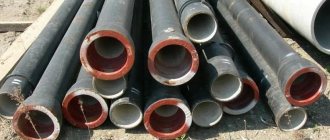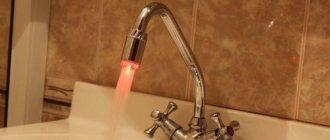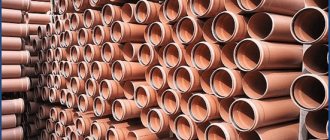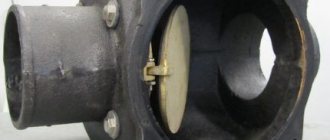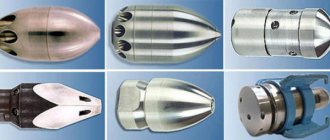Today, a comfortable stay in a country house or dacha, not to mention the private sector of cities and towns, is unthinkable without providing appropriate public amenities, among which the organization of sewage drainage plays an important role. It is a system of elements and pipelines connected to a centralized network, or an autonomous discharge system equipped with special settling filters. We will tell you about the advantages and features of each type, their design, methods and rules for installing external sewage systems.
Installation of external sewerage
- 1 Design and preparatory work
- 2 Equipment selection
- 3 Installation of external sewerage to the general network
- 4 Features of installation of autonomous external sewerage
- 5 How to avoid mistakes?
- 6 Cost of work
Design and preparatory work
The first stage of any home improvement work is an analysis of conditions and needs, and the development of a work project. In the case of installing an external sewer system, the first and most important issue is to determine the degree of autonomy of the system based on a number of factors, the main one of which is economic. The theoretical costs of building a line to the nearest sewer network are compared with the costs of creating an autonomous system with a septic tank, filtering and distribution system.
In the second case, it is also important to take into account the long-term costs and difficulties associated with maintaining and repairing equipment, as well as periodically pumping out the contents of the septic tank.
The second stage is planning, drawing up working sketches, determining the need for materials, and clarifying the cost of work. At this time, the location of pipelines and structural elements is developed, possible difficulties and ways to solve them are analyzed. The result should be a finished project, which should preferably be agreed upon with a specialist.
Types of containers for collecting waste water
As mentioned above, in private homes, three main types of storage tanks can be used to install an autonomous sewer system:
- Cesspool. Designed exclusively for the accumulation of wastewater. Must be pumped out periodically. Doesn't clean drains. May emit an unpleasant odor. Expensive to maintain, but cheap to develop.
- Septic tank. A container divided into several compartments in which wastewater undergoes a stage of natural decomposition into solid sediment and water. The sediment is periodically cleaned out, and the water is either discharged into the ground through drainage or pumped out. An inexpensive, but not very effective sewerage option for a private home.
- Local wastewater treatment plant (WTP). A set of equipment that includes a multi-section container, an aerator and other components. Due to the forced treatment of wastewater with oxygen from the atmosphere, the wastewater is purified up to 98%. It is clear that for such a degree of purification you will have to pay a pretty penny. However, in the future, savings on sewerage maintenance will show themselves.
Which option to choose depends, oddly enough, most often on the available budget. Even if you want your yard to not smell like sewer, and you don’t have to pump out wastewater two or three times a year, if there are no funds for VOCs, then there are none. Those who have the opportunity to invest money in a normal, modern, efficient and environmentally friendly sewer system choose local treatment plants.
Equipment selection
One of the most critical operations in the process of performing preparatory work is the choice of material and technical characteristics of the pipeline. If previously the undisputed leadership in the market belonged to cast iron pipes, in recent years they have partially lost their position to plastic (PVC) products. Debates about the best material continue to rage, as each provides specific benefits to the user. The advantages of cast iron pipes include:
- high mechanical strength;
- durability and reliability, especially when applying protective coatings;
- good sound insulation and thermal insulation;
- ease of creating high-throughput systems.
Here are the main advantages of plastic pipes compared to cast iron:
- lower price (in most cases);
- resistance to corrosion and chemicals;
- low weight, which facilitates transportation and installation;
- no need for complex plumbing and welding work.
Therefore, when choosing a material for each specific pipeline, it is necessary to take into account such operational characteristics as permanent and temporary loads on the pipeline from the external environment and flow intensity. In addition to choosing pipes, you need to decide on the configuration and type of additional elements. In any case, you will need adapters, turns, and fastening mechanisms.
Particular attention will have to be paid to the choice of equipment for an autonomous external sewerage system. You will have to select reliable filtering and drainage mechanisms (for example, a special well) that eliminate the possibility of groundwater clogging.
The most important element of the structure will be the septic tank. It is necessary to select its volume in accordance with the intensity of sewer discharges, on average - based on 1 cubic meter of capacity of one resident.
The installation location of the septic tank must not only correspond to the route of the main line, but also ensure the convenience of connecting the sewage system, since the contents of the septic tank should be pumped out at least once every two years. In this case, the permissible distance from the external walls of the house is at least 9 meters, and the minimum depth is 1.5 meters. In areas where deep soil freezing is possible, the depth indicator is further adjusted.
Prefabricated well
Last in the order of wastewater, but not in terms of its role in the operation of the sewerage system, is the collector or septic tank - a well into which sewage flows from the pipeline. The well is located so that it is at the lowest point of the drainage system.
Distance between the well and other objects located on the site and nearby:
| An object | Distance not less, m |
| non-residential outbuildings | 1 |
| residential buildings | 5-7 |
| water well | 50 |
| fence between plots | 2 |
| open waters | 15 |
Types of wells
For a private home, you can equip a well of one of three types:
- storage well or collector - a sealed container into which wastewater flows; when the collector is filled, the sewage is pumped out;
- a well with post-treatment, a septic tank - a container of several series-connected chambers in which wastewater gradually settles, the sediment is processed by bacteria, and partially purified water enters the last of the chambers and from there goes into the soil;
- deep treatment station - a well with filters and a bioreactor (a set of substances and bacteria), in which wastewater is purified from dangerous microorganisms and safe organic matter is separated, the purified water goes into the soil, and the separated organic matter can be used as fertilizer.
We recommend that you read: How to install plastic pipes yourself
The first two types of wells can be equipped with your own hands. Ready-made plastic containers or reinforced concrete rings are used for these purposes. Septic tanks are also built from brick and concrete.
It is difficult to equip a deep cleaning station with your own hands, as it requires special knowledge. It is easier to buy a well of this type and install it ready-made in a prepared pit.
Installation of external sewerage to the general network
This is a simple method of installing an external sewage system for a building, which, after drawing up and approving the project, includes only three stages.
The first is the acquisition and delivery of materials and elements, final work with the internal sewerage system, that is, combining its lines and leading them outside.
The second stage is the most difficult and includes land work. First, the area is marked. Every 1.5-3 meters, as well as at all points of change in the trajectory of the highway, install the first row of stakes, connecting them with a nylon thread.
Then, at a distance twice the diameter of the main pipes, a second row is installed. The compliance of the markings with the plan is monitored, after which trenches are directly dug. The depth can vary quite widely, but most likely you will have to dig a lot - the pipe should go to the very bottom of the sewer well.
An important condition for high-quality execution of earthworks is maintaining a slope that will allow the movement of liquid by gravity, but not by a concentrated flow. The minimum permissible slope is 8 mm per meter, the recommended one is from 1.5 to 3 cm. Often, regulatory documentation also gives a slope value of 1 degree.
You can control the slope of the trench using a board laid on its bottom with a level set on it, as well as an ordinary ruler, but this should be done after laying and wet compaction of the sand cushion for the pipes.
The third stage is the actual installation of the external sewage system. It includes cutting and forming pipes, combining them into a single system, and laying them in trenches. Upon completion of installation, the slope of the main line is checked again, and a connection is made to the internal sewerage system and the main sewer network.
The pipeline is tested - for this purpose, an intense flow of water is released through it, and the sand cushion along the entire length of the trenches is periodically checked for leaks. If they are not there, the installation is considered complete, the pipes are covered with 10-15 cm of pitch to absorb stress, the trenches are covered with earth, and the profile is leveled. Otherwise, areas of leaks are marked and sealed after the liquid has dried, after which re-inspection is carried out.
Optimal depth for laying sewer pipes
To install a sewer system on your personal property, you will need to comply with sanitary requirements. They prescribe the required depth of pipes. In addition, you must follow all installation rules.
In areas with different soil heights, inspection wells will need to be installed. In addition, they are mandatory for direct laying every 25 m.
The laying depth should be 30 cm lower than the soil freezing level. But if there is a large load on the ground, then the pipeline is laid at a depth of 9 m. This option is used for highways.
Standards for sewerage installation:
- The soil in the trench will need to be compacted in advance. This will help strengthen the soil.
- The slope of the pipes will need to be observed. There is no pressure in the sewer, so this requirement is mandatory. For each linear meter, apply several centimeters of slope.
- Each turn is equipped with an inspection well.
Sewerage reinforcement must be reliable. The bottom of the trench is covered with a 15-centimeter layer of sand. The same pillow is made on top of the pipes.
Features of installation of autonomous external sewerage
It is obvious that autonomous sewerage is more complex in design and requires compliance with specific requirements due to the presence of additional elements in the design.
The first thing to do is to mark the area in accordance with the technology described above, but additionally mark the exact installation locations of the septic tank and filter well with drainage system, or drainage pit. An important rule, without which an autonomous external sewerage system will hardly be able to function properly, will be the direction of installation - unlike a centralized sewerage system, the line does not lead from the house, but to the house.
Let's begin our consideration of the technology for installing external sewage systems of an autonomous type with drainage pits, as a simpler, albeit outdated, method of waste disposal. In accordance with the marked perimeter of the pit, excavation work is carried out, which is an extremely labor-intensive process. The use of special equipment can simplify it. When digging a hole by hand, it is important to constantly control the shape of its walls with a level - it must be strictly vertical, without “collapsing” outward. After completion of the excavation work, the bottom and walls of the pit are laid out with bricks, leaving drainage holes and a window for the entrance of the sewer pipe.
Then they dig trenches and lay pipes according to the method described above, with the exception of one nuance - laying pipes of autonomous systems can be carried out much higher, even in a frozen soil layer, since wastewater moves through the system periodically, and not constantly, and is characterized by a relatively high temperature.
In conclusion, I would like to remind you that the use of drainage pits not only creates a lot of inconvenience, but can also be illegal if it is determined that the discharges pose a danger to groundwater. A much safer and more promising way to install an external sewer system is to equip it with a special device - a septic tank. Let's consider the technology for organizing such a system.
First, excavation work is carried out in the places where the septic tank is installed and the well is constructed, and two trenches are dug. The first, relatively shallow, connects the house and the septic tank pit, the second, of greater depth, connects the pit and the well.
At the next stage, the bottom of the pit is insulated, for example, with penoplex. This is necessary to prevent freezing of stagnant liquid in the device, as well as for the normal flow of bacterial life processes, which are a necessary condition for the safe decomposition of waste. After insulating the pit and carrying out all related work, the actual installation of the septic tank is carried out. In this case, it will be most convenient to use the services of a manipulator car. The neck of the septic tank must be at ground level.
They begin to build the well. There are two acceptable methods here - laying the walls with bricks or installing concrete rings. The second is simpler, but requires the use of special equipment, as well as preliminary chiselling of holes in the rings for the location of elements of the drainage system. Brickwork allows these openings to be provided during the construction of the walls.
When the construction of the well is completed, they begin to install drainage pipes, the lines of which are more convenient to provide at the stage of excavation work.
Drainage pipes ensure the distribution of purified water in the ground and can be located linearly in a horizontal plane, or diverge in different directions - orderly or chaotically. It is worth noting that recently, ready-made, industrially manufactured plastic drainage wells have become increasingly widespread.
The next stage is laying the main pipes. There is nothing new here - a compacted sand cushion, installation with cutting and connections, and at each stage - control of the compliance of the actual slope with the standard one.
We remind you that the direction of installation is from the septic tank to the house and from the well to the septic tank. Particular attention is paid to the joints of pipes and elements.
Thus, the entry point of the main pipe into the septic tank must be made movable in order to prevent the destruction of the pipe during the almost inevitable subsidence of the septic tank over time, but at the same time ensure its tightness. All technological openings should be covered with a layer of polyurethane foam or other similar substance.
It is important to take timely care to install an air valve, which will help reduce pressure in the system and ensure its normal functioning.
Next, a comprehensive tightness control is carried out at the highest possible flow intensity, identified faults are eliminated, the trenches are backfilled using the sand-earth method, and the upper profile is leveled.
The soil is added to the septic tank until it is completely compacted. Now the installation of the system can be considered complete. All that remains is to carry out timely and high-quality maintenance of the elements, and first of all, pumping out the contents of the septic tank.
Types, specifics
There are several types of external parts of the system. They are combined into groups according to certain characteristics. Based on the principle of movement of wastewater, external sewerage is divided into 2 categories:
- gravity flow. It is created in such a way that all elements are located at a slope. Drains move under the influence of gravity. The angle of inclination of the pipes is strictly limited and represents its own value for each diameter;
- pressure (or forced). These are systems located in areas with difficult terrain, lowlands, on slopes, etc. Special pumps are used to supply wastewater.
Usually they prefer to build the first type of systems, since they are simpler and cheaper. By waste disposal method:
- public The liquid from the house enters the main lines, from where it is transferred to the city wastewater treatment plants;
- autonomous. These are relatively small systems serving one home. They independently dispose of wastewater, or, at a minimum, accumulate it in a large reservoir until pumping.
Construction of a sewer system of one type or another requires knowledge and compliance with standards and requirements. Since the penetration of wastewater into the ground is fraught with many problems, all distances from system elements to buildings and structures are predetermined and strictly controlled. Installation of external sewerage is carried out on the basis of a plan, which is drawn up taking into account the standards of SNiP and SaNPiN. Regardless of whether a connection is being made into a public network, or an autonomous complex is being built, compliance with the current rules is mandatory.
How to avoid mistakes?
The following tips will help you install an external sewage system quickly and efficiently, as well as avoid some basic mistakes:
- Show the preliminary draft to experienced professionals, listen to their comments and make the necessary changes.
- Do not skimp on materials - this price difference is not comparable with the cost of repairs that may be necessary if the elements contain technological defects.
- Although this is not a requirement, consider insulating the pipes with polystyrene foam or polyethylene foam (mineral wool should not be used). This additional reinsurance will protect sewer pipes from particularly harsh weather and climatic conditions.
- Follow the folk wisdom “measure twice, cut once” - carefully and efficiently cut and adjust sections of the pipeline, strictly observe the required slope angles, and do not forget about checking the tightness.
- Ask the seller about the composition and quality of protective coatings on the internal surface of the septic tank. It is considered optimal to apply two layers of bitumen on top of the primer layer. If cast iron pipes are used, it is better to opt for products with durable anti-corrosion coatings.
- Pay special attention to the quality of drainage pipes. If they are clogged or have low capacity, water may stagnate in the well, which can lead to a number of unpleasant consequences.
But the main thing is to follow safety rules, especially when using dangerous tools or being near working special equipment.
Conclusion
External sewerage is perhaps a more important component of the wastewater disposal system at a summer cottage than the internal part of this utility network. To clearly see the installation process, you can watch the video in this article. And if you have any questions or your own advice, you can leave them in the comments to the material.
Did you like the article? Subscribe to our Yandex.Zen channel
July 18, 2021
External sewerage, Sewerage
If you want to express gratitude, add a clarification or objection, or ask the author something, add a comment or say thank you!
Punching method
The punching method is intended for laying metal pipes of large diameter (from 800 mm). And one of its main features is the absence of the need to dig a trench. This method is used for pipelines no longer than 80 meters. The essence of the method is that hydraulic jacks press a steel case with a knife at the end into the ground. It pours into the pipes, then they must be cleaned manually.
This method is widely used when laying pipelines under various structures, highways and rails. It is also involved in the construction of water, oil and gas pipelines, and the installation of sewers. In addition to the fact that large diameter pipes can be used in this way, there are other advantages: relatively low costs and speed of work.
Professional secrets
Assembling a sewer system is not a difficult task, however, there are some nuances here:
- installation is carried out from the riser in the direction of plumbing fixtures;
- the pipe sockets should be directed from the riser to the plumbing fixtures - in this case, the likelihood of leakage will be minimal;
- turning the line 90 degrees is carried out using two 45-degree bends - this will reduce the risk of blockages;
- for each of the plumbing fixtures it is advisable to use a siphon with a water seal;
- connection to the pipeline of drain hoses and sections with a smaller diameter of pipes is made through rubber cuffs that ensure the tightness of the connection;
- when assembling a pipeline from several materials:
- When connecting a plastic line to a cast iron riser, it is necessary to use transition elements specially designed for this purpose.
It is necessary to provide revisions in the system to service problem areas of highways.
The dimensions of plumbing hatches for hidden installation must provide access to all connections of the system.
How to properly install sewer pipes with your own hands, watch in the video filmed while the plumbers were working.
Installation of a classic septic tank
As an example, we can consider the most commonly installed equipment today - a plastic septic tank with forced aeration and a drainage well. More expensive VOCs are installed by analogy.
The sequence of work is as follows:
- Selecting an installation location (see recommendations and standards above).
- Excavation. To install a septic tank, a pit is prepared at a depth corresponding to the dimensions of the tank. The width and length of the hole is made with a margin so that later the septic tank can be properly sprinkled. The removed soil will not be useful in the future, so it can be removed immediately.
- Preparing the base of the pit. A sand cushion is placed at the bottom of the pit under the septic tank. If the local soil is excessively susceptible to heaving, then appropriate embedded parts are prepared to anchor the container. The height of the classic pillow is 20 centimeters.
- Installation of a septic tank. It is placed in its permanent place either manually (if the weight and availability of working hands allows) or using a mechanical manipulator.
- Connection to the main line and power supply (if provided by the equipment package).
- Backfilling. For this purpose, it is best to use a dry cement-sand mixture. The septic tank is filled with ordinary water as it is sprinkled to prevent deformation of its walls.
- Test. Carried out after final installation work.
Depending on the configuration and type of cleaning equipment, the installation process may differ slightly from that described above, which is usually indicated by the manufacturer in the description of its product.
Place for installing a septic tank
The next most important point in arranging an external sewer system is the question of the location of the septic tank (cesspool, VOC). When solving this problem, the following distances are taken into account:
- to a residential building - from 4 meters;
- to a well or well with drinking water - from 50 meters;
- to a garden with trees - from 3 meters;
- to a river or lake - from 10 meters;
- to an artificial reservoir - from 30 meters;
- to a public road - from 5 meters;
- to the neighbor's plot - from 3 meters.
In addition, the location of the septic tank should, if possible, be at the lowest point on the territory. Additionally, despite the above norm, it is recommended to coordinate this issue directly with the neighbors before starting work (sometimes even 5 meters cause a terrible scandal). Completely sealed septic tanks are allowed to be installed closer than 4 meters from a residential building.
External gasket
It is considered the easiest way to install the necessary pipes. On the other hand, pipeline systems remain visible, which is not always appropriate from the point of view of the attractiveness of the building. Among the advantages of the described method, it makes sense to highlight the following:
- Simplicity. Heating installation is carried out quite quickly and does not require various preparatory measures.
- Availability. If necessary, the pipelines can be repaired without any problems since they are easy to access.
- No heat loss. Since the surface of the pipes does not come into contact with the wall structures or floor, the heat does not disappear anywhere, but is distributed throughout certain rooms.
- Economical. To lay pipes along the external areas of various building elements, small amounts of different materials are required. No adapters, no insulation products, or putty are needed.
Hidden way
There may be obstacles on the plot that interfere with excavation work: trees, buildings and other landscape objects. In this case, it will not be possible to lay the sewer using an open method, so you have to turn to specialists who can lay the pipeline without disturbing the integrity of the soil.
The hidden method of laying sewers is otherwise called the puncture method.
- A special drilling rig is used to dig a pilot well underground from the location of the well to the home sewer pipe.
- The well is expanded to a diameter 1.5 times greater than the cross-section of the pipeline.
- The end of the pipeline is attached to the nozzle at the end of the drill and pulled into the well.
Note! The disadvantage of the hidden method is the possible error in the geometric shape of the pipeline. Since the drill is controlled remotely, the slope or straightness of the pipeline may be affected.
